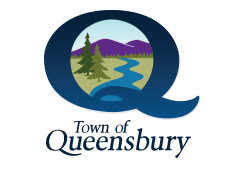A Brief History of Queensbury NY
Queensbury was once a part of the great northern wilderness – a favorite hunting and fishing site for the Iroquois during the summer and a route over which their war parties traveled on the way to Canada. During the French and Indian War, the Colonial Army Marched through here from Albany in August, 1755, building a road as it marched. This Military Road was the first road – the link leading to settlement of the Town of Queensbury. Sometime between 1759 and 1762, Jeffrey Cowper became the first settler in Queensbury when he was given permission by British General Jeffrey Amherst to occupy the post used during the French and Indian War, the troops having moved by then to Crown Point.
As the French and Indian War was drawing to a close, the English Lt. Gov. James DeLancy of the Province of New York issued a proclamation to encourage settlers to the area between Albany and Montreal if they would immediately settle and establish a township. Daniel Prindle from Connecticut applied for a patent of 23,000 acres, but one month later sold the patent to Abraham Wing and his group of 31 Quakers at the Oblong in Dutchess County. The Queensbury Patent, date May 1762, granted by King George III of England, was named in honor of his consort, Princess Charlotte of Macklenburgh Strelitz. In August of that year, Wing arrived here with a surveyor, Zaccheus Towner, and began surveying the township and dividing the land into lots. The work was completed by November. In the summer of 1763, Abraham Wing and Ichabod Merritt moved from Dutchess County and began to carve out new homes in the wilderness. The village was to have been laid out at the Halfway Brook where a small clearing had been made around the original fort, but growth actually sprang up around the falls at the river, where Wing erected a saw mill and grist mill. By the end of the first decade, about two dozen log homes were located in the area, and a few rudimentary roads and bridle paths had been established.
Life in this wilderness would prove to be beyond the endurance of the hardy and peace-loving Quakers during the Revolutionary War. They suffered repeatedly from military requisitions and twice their dwellings were burned. The Quakers retreated to Dutchess County. However, when the Revolutionary War ended in 1783, the Quakers returned and began rebuilding the community. By the following year, frame houses appeared, roads were being constructed and new settlers were arriving. At the same time in the northern part of the Township, the Harris family was developing the “so-called” Harrisena patent, about 2,000 acres bought by Moses Harris, Jr., after the Revolution. Later, other large tracts were added, and by 1788, Queensbury’s boundaries included all of what is now Warren County.
Clearing the land and preparing the fields for planting was the first order of business. Saw mills and grist mills were early requirement and agriculture was simply for subsistence. The mills were located around the falls in the Hudson River and along small streams and ponds which dotted the Township and provided water power. The trees were a natural resource and lumbering became the primary industry.
About 1824, a small quarrying operation began by the river where lime rock beds were found below the falls. Besides the limestone deposits, gray and white marble, found at a deeper level in the beds, were extensively quarried and the products shipped to world markets. In 1865, part of a grist mill, black marble and lime quarry complex, known as the Glens Falls Company, was bought by Jeremiah and Daniel Finch and Samuel Pruyn. The Finch, Pruyn Company developed into the largest lumber business on the Hudson River by the mid-1890’s. In 1904, the company expanded into newsprint production.
As the settlement grew, transportation improved. In 1832, the Feeder Canal was opened, providing transport for lumber, lime, and other products of the area. A plank road was built between the village of Glens Falls and Lake George along the route of the old Military Road in 1848. This led to the stagecoach era, and Lake George and points north became resort areas. In the latter part of the 19th century railroads replaced the stagecoach. Soon after the turn of the century, the horseless carriage made its entrance. Thus, with the village of Glens Falls’ continual growth and the resorts further north, farming became a major business, providing dairy products and produce. By the 1870’s, agriculture was firmly established and reached its peak about the turn of the century.
In 1908, the City of Glens Falls was incorporate, separating it from the Town of Queensbury. But the Town continued to grow. Floyd Bennett Field opened in 1928 on Miller Hill, and airfield named in honor of a local pilot who flew Admiral Byrd to the North Pole. World War II brought new industries and new citizens to the Town. Postwar development led to numerous housing and commercial developments and shopping malls after the Northway section of I-87 was built and Quaker Road was completed in 1961.
Today, Queensbury is noted for its tourism trade. Motels, restaurants, amusement parks, golf courses, ski trails, etc., abound, serving thousands of tourists each year. The resulting increased responsibility for the Town government has led to the preparation of a land use map; a zoning ordinance; subdivision regulations; and establishment of a Town Planning Board and a master plan. During this tremendous growth, the Town erected its first government complex on Bay Road, opened in 1966, to keep the various elements of the Town government in close proximity for the task confronting it. Today, the Town government has changed little from its original form. It has been flexible enough to perform as efficiently as it did in 1763.
Links



